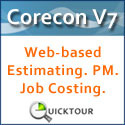
|
www.agc.org Contact Us Archives/Subscribe Advertise IT Forum IT Forum Steering Committee |
Centered on ClaimsBy Cecilia Padilla, President In a perfect world every job runs smoothly; there are never delays, everything is done in sequence, and contractors make the profit (or better) identified on bid day. Unfortunately, construction projects are rarely perfect. Material shipments are late, incomplete or just wrong. Other trades fall behind in their work and that causes delays for the crew. Even the weather can affect the project. Contractors may be asked to jump around and work out of sequence and as a result overtime may be forced on the crew. When the economy was better, an important strategy was to pick the territory wisely, hand pick the clients, choose the kind of work that was in the sweet spot and negotiate a project rather than hard bid it. In a stronger economy, contractors think in terms of relationships. In a down economy, like now, contractors find themselves hard-bidding jobs against 30 competitors, bidding on jobs out of town, working for clients that are difficult and for whom they would not typically work. Contractors find themselves fighting tooth and nail for every dollar and focusing on every change order. Projects naturally start from a place of stress. Managing the project each and every day is the foundation to maintaining profits and winning claims. There are a lot of reasons why contractors don’t worry about the claims process. Some are listed below:
Project managers (PMs) are responsible for tracking a great deal of information. Equally important is performing analytics on this data. PMs must track original estimated quantities of materials and labor hours. They must measure the installed materials and the corresponding completed labor hours; this includes the percent complete to the calculated earned value. The inclusion of actual payroll data brings a higher level of accuracy to the project that helps determine its success or failure. The need to file claims puts a lot of stress on the project and the team. It is better to go on the offensive with up-front strategic project management in order to be prepared for claims. This article discusses best practices to address the claims process. If a contractor implements these steps it will not eliminate or prevent the need for a claim to be filed. It will, however, put the contractor in a far stronger position to defend himself and subsequently win the claim outright. There are five essentials to strategic project management – Scope, Resource, Time, Money, and Documentation. If the job shifts from perfect to imperfect, these five fundamentals will determine whether the contractor makes money on the job or if there is enough information to win a claim. SCOPE RESOURCE TIME MONEY DOCUMENTATION The other important aspect of documentation is tracking the measured mile. It is a legal premise where contractors measure off effected work. Identification of the estimated time to complete is compared to the actual time spent. Analyzing the factors that caused the cost overrun is most effective when using automation tools because the work is time stamped and easily reflects the work status. Photograph and take videos of the situation and store the support data within the automation tool then carry the tablet into the meetings. Creating solid documentation takes away the ‘your word against theirs’ weak-link in a claim. Dealing with claims is a very time consuming and stressful activity. It detracts from the core business. A claim isn’t a strategy to make money but rather filing a claim is a way to avoid losing money or to recover money. Therefore it is best to do everything possible throughout the project lifecycle to be prepared for claims. Start from a position of strength. Focus on the five essentials – Scope, Resource, Time, Money, and Documentation. If the claim is well documented, the other parties may not push back once the information is shared. Strategic and proactive project management is the argument-winning tool for a claim. Cecilia Padilla, president of On Center Software, Inc. is an internationally known expert in the construction industry. Under the leadership of Mrs. Padilla, On Center Software introduced Digital Production Control™ patented labor control technology, increased customer support accessibility, and launched On Center University to better educate and train customers and partners. She serves on the firm’s executive Vision Team, a think tank for the future of construction automation. In addition, she is a respected estimator and project manager in the drywall industry. Like many professionals in construction, she is a second generation construction professional. Mrs. Padilla’s expertise spans 25 years in drywall, light- and heavy-gauge framing, lath and plaster, EIFS, fireproofing-themed facades, and acoustical ceilings.
|

2300 Wilson Boulevard, Suite 300 · Arlington, VA 22201 · 703-548-3118 (phone) · 703-548-3119 (fax) · www.agc.org
About AGC | Advocacy | Industry Topics | Programs and Events | Career Development | News & Media
© Copyright 2025 The Associated General Contractors of America. All rights reserved.


